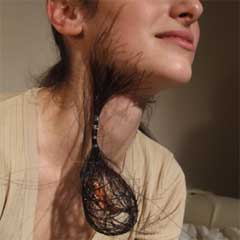 Another project from the Royal College of Art design interactions show. There were several digital pieces, but also some works inspired by the advances of other technologies. Although they might surprise many visitors, the biotech-inspired projects received very interesting response form industry people, some of them explaining that it was getting tired before, that the same ideas kept reappearing, but now they can see a space opening for new and unpredictable ideas and possibilities. They realize too that the times are a changing, and that you need to develop technology within a more complex setting. I cannot agree more with that.
Another project from the Royal College of Art design interactions show. There were several digital pieces, but also some works inspired by the advances of other technologies. Although they might surprise many visitors, the biotech-inspired projects received very interesting response form industry people, some of them explaining that it was getting tired before, that the same ideas kept reappearing, but now they can see a space opening for new and unpredictable ideas and possibilities. They realize too that the times are a changing, and that you need to develop technology within a more complex setting. I cannot agree more with that.
Inspired by the Hygiene Hypothesis which states that a lack of early childhood exposure to infectious agents increases susceptibility to allergic diseases, Michael Burton‘s series of work considers an alternative symbiotic and ecological embedded healthcare and way of life. The Race takes a looks at our obsession with bacteria. Although we are healthier when we are surrounded by the bacteria we have co-evolved with through our species evolutionary development, we keep spraying our homes with antibacterial products that promise to eliminate 99.9% of all bacteria. How do we find our way out this paradox, and what might a counter reaction to the hyper-hygienic era look like?
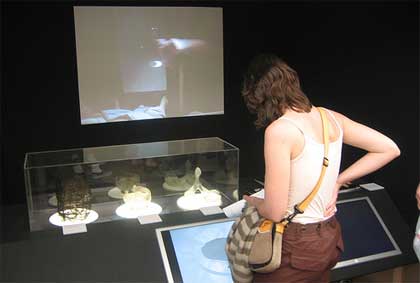 Michael and maggots corner at the RCA show
Michael and maggots corner at the RCA show
“The microbes that live in the human body are quite ancient,� says microbiologist Dr. Martin Blaser. “They’ve been selected (through evolution) because they help us.�
It now appears that our daily antibacterial regimens are disrupting a balance that once protected humans from health problems, especially allergies and malfunctioning immune responses.
“The world is very aware of the concept of global warming, which is a macro-ecological change,� Blaser explains. “I postulate that there are similar micro-ecological changes going on inside us.�
Antibiotics underpin all of modern medicine. Alarmingly, we are nearing the end of the antibiotic era. Bacteria and viruses are evolving faster than scientific innovation. Trivial infections we hardly think about now will once again become fatal.
The Race proposes that we must now join the race to evolve with them. It also presents a mirror to ourselves to question personal and societal lifestyle practices and our self-perceived superiority over other organisms. Who do we think we are?
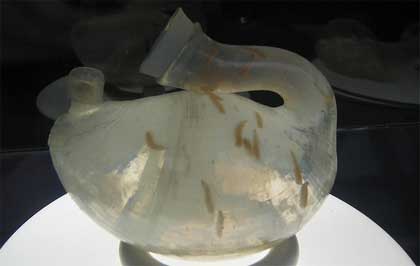
A first project is concerned with maggots which have been used throughout medical history as a painless way of treating wounds because they remove dead and infected tissue, while leaving healthy tissue intact. But they fell into disuse when antibiotics were first introduced in the 1940s.
Medics now recognise that maggots have advantages over more recent forms of treatment, as they kill the bacteria that cause infection, including the so-called antibiotic-resistant superbugs. There is also some evidence that maggots also stimulate the wound to heal. Their re-introduction in hospitals could therefore enable NHS to save millions.
Maggot Cohabitation encourages us to invest in the symbiotic relationship pre and post treatments. You are encouraged to keep at home special portable receptacles that would allow you to follow the life cycle. The maggots would be delivered as larvae to your home and you carry them to the hospital. At the end of the treatment, you’d release them as flies, and they would take your genetic material with them as they fly away which is much more poetic than the current practice which consists of incinerating the maggots once they have finished their healing job.
Another chapter of The Race is called Pet Dander.
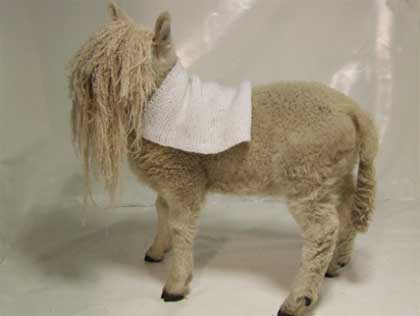 Pet Dander
Pet Dander
Domestic animals kept in the home may help boost human immune systems by exposing them to a wealth of pet dander, which is the dead skin cells, hair and parasites the animal harbours.
However selective breeding practice and genetic engineering have enabled the creation of a new league of pets like the Labradoodle and the Allerca hypoallergenic cats. Marketed as hypoallergenic lifestyle pets, they are designed not to expose humans to allergenics like pet hair. The practice unwitingly strips our cohabitation with these animals from the health benefits they once had.
With our revised understanding of health, the hybrid animals envisioned by Michael are designed specifically to harbour pet dander, dead skin, hair and pet parasites in order to desensitize and strengthen their human co-habitants immune systems. The animal would have a dense coat, perfect for harbouring parasites, sheading its hair and has a natural behaviour to forage and graze, collecting dirt and bacteria as it does and it would generously pass the parasites to you as you’d embrace and pet it.
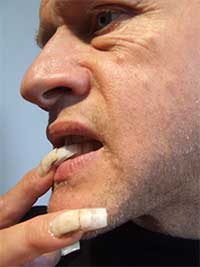 Another idea, named Commensal Bacteria, proposes new manipulations to the human body and changes in behaviour and manners which would have us develop commensal relationships with bacteria and other microbes to enrich the gut microbiota.
Another idea, named Commensal Bacteria, proposes new manipulations to the human body and changes in behaviour and manners which would have us develop commensal relationships with bacteria and other microbes to enrich the gut microbiota.
Fingernail growth would be engineered to increase the surface area where bacteria can thrive. Biting nails would be encouraged as a means of consumption. Teamed with very specific micro-environments this is a desirable way of consuming dirt and particularly the bacteria Mycobacterium vaccae, to boost health and well-being.
Michael developed several other scenarios which are inspired by science facts, including the use of tapeworms as contraceptive, excessive hairgrowth harnessed to breed organisms, etc. Follow his research on his blog.
